Test Questions
Test questions are assigned in tests to be processed by learners. Assignments to test templates are also possible.
The questions exist in multiple languages, allowing learners to choose in which languages the questions are displayed.
Test questions are versioned. If a new version is created, existing tests will not be updated automatically, so as not to overwrite existing entries. Duplicating test questions allows to create similar questions very quickly, without repeating all settings for each question individually.
The classification of test questions facilitates the selection of questions upon assigning them to tests and test templates.
Upon assigning points to test questions, different options are available. Depending on what is appropriate for a given question, it can be determined whether points are to be awarded only if the whole question was answered correctly or if points are also awarded for partially correct answers. Negative points can be awarded, as well.
The following question types are available:
Yes/No: One out of two possible answers is highlighted. Example: Is Mount Everest located in Europe?
Single-choice: One out of two possible answers is highlighted. Example: In which mountain range is Mount Everest located?
Multiple-choice: One or more out of multiple possible answers are selected. Example: Which of the following mountains are located in the Himalayas?
Matrix: One possible answer in a matrix is selected. Example: x-axis with mountain-range names, y-axis with mountain names.
Association: Gaps in a logical chain or term matrix are filled. Example: Matterhorn - Alps - Europe, Mount Everest - ... - Asia
Fill in the Blank: Texts with free-text or drop-down fields are filled. Example: Mount Everest was first climbed by ... in the year ... .
Image section 1 of n: An area in a picture is marked. Example: Please mark the tree line of the mountain in the picture.
Image-area x of n: Several areas in a picture are marked. Example: Please mark which objects in the image are used for locomotion.
Drag & drop 1 to 1: Elements are distributed to target areas using the mouse. Example: Drag the correct flag into the corresponding country field. Only one object can be dragged into each field.
Drag & drop n to 1: Elements are distributed to target areas using the mouse. Example: Drag all mountain names located in the Alps into the upper box and all others into the lower box.
Free text: The answer consists of a text. Example: Please describe the ice formation. It can be specified whether next to or instead of a free text field the learner should be offered the possibility to upload a file attachment as an answer to the question. The upload restrictions configured on the system apply.
Arrange: Objects need to be assembled in the correct order. Example: Place the mountains in order by height.
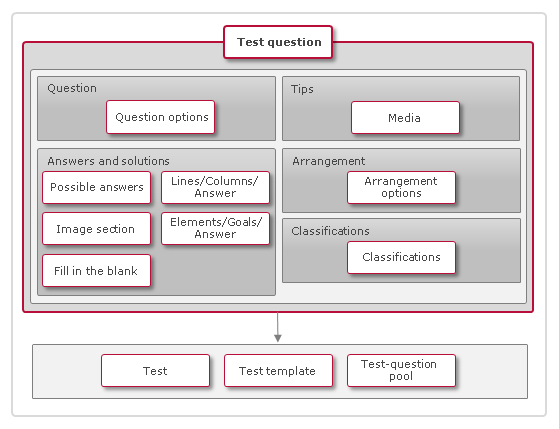
Illustration: Use and Application of Test questions
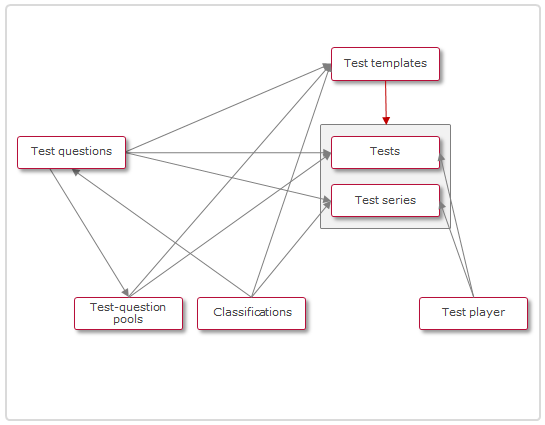
Illustration: Relationships between test objects
Functions of the Test Question Manager
New
General Structure
Question management is conducted via multiple tabs that can be opened flexibly. The structure of the individual tabs differs by question type due to the specific configuration options.
The following tabs are available for the respective question types:
Description
Name, description, keywords, available languages, test modes, target learning-objective level and processing time are determined as general description attributes.
Question
This tab is available for question types and includes all indications connected with questions (e.g. question text, feedback, total points).
Possible Answers
The "possible answers" tab is available for "Yes/no", "Image-area single-choice and multiple-choice", "Close", "Single-choice", "Multiple-choice" and "Order questions", to ensure the collection of possible answers and justifications.
If points are awarded per possible answer, positive and negative points can be awarded as well.
Lines/Columns/Solutions
For association and matrix questions, the "Lines" and "Columns" tabs determine the structure of the question. The solution tab defines correct and incorrect solutions per line/column combination, as well as their scores (if enabled at the answer level) and justifications.
Image Area
For the question types "Image-area" single choice and multiple choice, the appropriate tab defines possible areas within the uploaded image for each defined possible answer.
Elements/Targets/Solution
For drag & drop single assignments and drag & drop multiple assignments, structure definitions are conducted via the elements and targets tabs. The elements define the objects that can be dragged into one or more target boxes. The size can be determined manually or automatically for both elements and targets. On the basis of correct assignments of elements to targets, the solution tab defines correct and incorrect solutions.
Cloze
For cloze questions, the text as well as the gaps it contains are defined in the appropriate tab. The gaps, along with their correct answers, are defined in the possible-answers tab and filled in via a variable.
Note
Hints can be uploaded from files or imported from media. Hints will be shown for appropriate test questions. The administrator determines if they are displayed during the processing of a given question or as a follow-up action once a correct or incorrect answer is submitted. Further, it can be determined if the currently published version of a medium is to be used as a hint or the one that was originally added, as well as if the medium is to be shown if the test language does not match the language of the medium.
Display
The definition of the "Display" tab depends on the question type how possible answers are displayed (e.g. horizontally or vertically) and where media elements belonging to the question or the possible answers are placed.
Classifications
ClassificationsNewSpecific Question Types
Questions differ in the settings of the possible answers, the selection of correct and incorrect answers and the distribution of points:
Association
Line and column headings are defined as text or image or both. Fields are defined as to be filled out or already filled out. It is recommended to allow for multiple spellings (e.g. "fotograph", "photograph"), multiple possible answers per gap (e.g. "computer", "PC"), and, optionally, capitalisation variations. Points can be awarded per possible answer or per question.
Image Area (1 of n and x of n)
Images need to be uploaded. Areas are defined and marked as correct or incorrect solutions. Points can be awarded per possible answer or per question if multiple areas can be selected.
Drag & Drop (1 to 1 and x to 1)
Elements, target areas, and the right assignment from both are defined. Elements and target areas can be defined as images or text or both. The size of the target areas can be determined manually or automatically, according to the anticipated possible answers. If the possibility of multiple assignment choices applies, points can be awarded per possible answer or per question.
Free Text
Free-text questions have to be evaluated manually by tutors or correctors. Fees for first, second, and third corrections can be entered. In contrast to the other question types, there will be feedback on the answer, regardless of whether it is correct or incorrect. Sample solutions and justifications can be deposited directly.
Yes/No
The designation of the alternatives "Yes" and "No" can be changed in any way. An image can be uploaded for each possible answer.
Fill in the Blank
Gaps are defined as free text gaps or gaps with fixed selection options (drop-down). It is recommended to allow for multiple spellings (e.g. "fotograph", "photograph"), multiple possible answers per gap (e.g. "computer", "PC"), and, optionally, capitalization variations. The cloze text and the placement of the gaps are defined. Points can be awarded per possible answer or per question.
Single Selection
Any number of possible answers can be created, from which one is selected as a solution. An image can be uploaded for each possible answer.
Multiple Selection
Any number of possible answers can be created, to which points can be assigned for correct and incorrect answers. Points can be awarded per possible answer or per question.
Matrix
Line and column headlines are defined as text or image or both. Correct answers are selected. Points can be awarded per possible answer or per question.
Arrange
Any number of possible answers can be created. The possible answers need to be arranged in the right order. For each possible answer, an image can be uploaded.
Export
Below the XML export of test questions, an option is available that allows to perform the export to an Excel file. Only single choice, multiple choice and Yes/No questions can be exported to the Excel format. In case other types are selected, "Export for Excel" will be greyed out.
When performing the Export for Excel, 2 options will be available based on Administrator’s preference. It is possible to trigger an export in all available languages or in specific languages chosen by the Administrator.
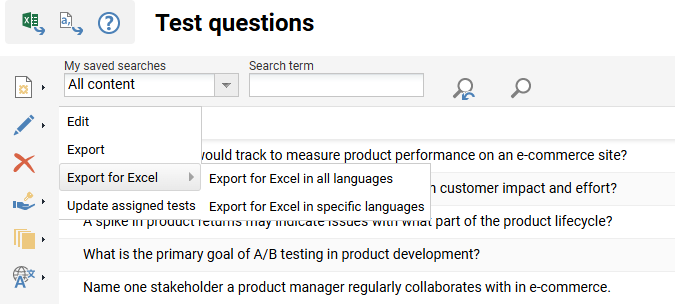
Illustration - Export for Excel in all languages or in specific languages
When selecting the 'Export for Excel in specific languages' option, a pop-up will be displayed to the Administrator, where the available languages in which the test questions were created (not the platform languages) will be displayed and available for selection. When at least one language is selected, the Export button will be enabled and after clicking on it, the Export will be triggered.
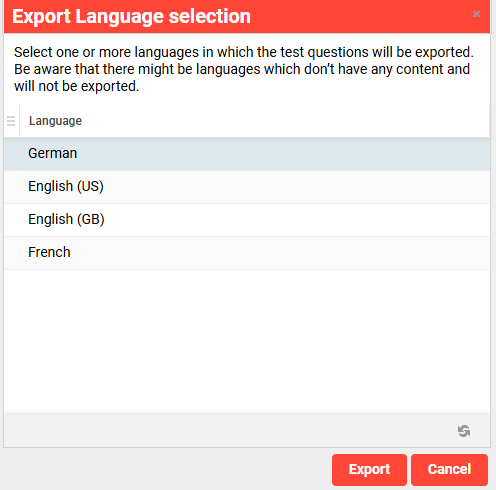
Illustration - Export Language selection
If multiple test questions are selected, the pop-up will display all the languages from all the selected test questions.
If the export completes successfully, a confirmation message will appear. However, if multiple test questions and languages are selected during export, and one or more languages are unavailable for certain questions, the user will be notified through the same Export Question pop-up. The message will specify which question-language combinations were successfully exported and which were not. As a result, the Excel file will exclude any questions or languages that could not be exported.
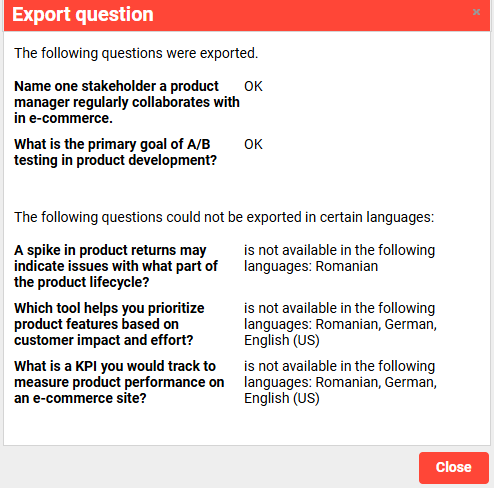
Illustration - Example with questions successfully exported and errors
Global Functions and Related Topics
SearchLanguagesTest ManagerTest TemplatesTest Question Pools
